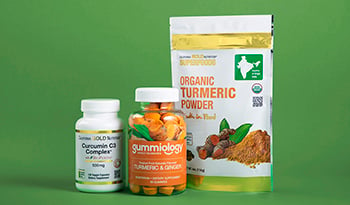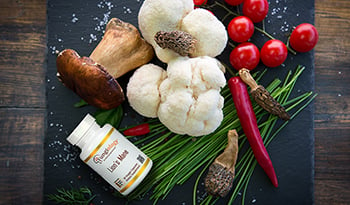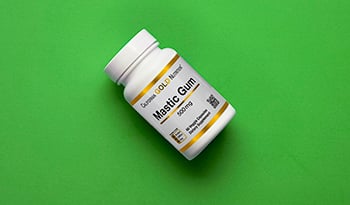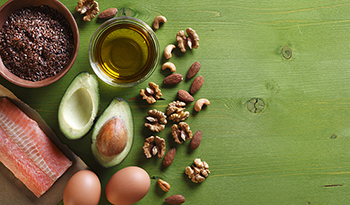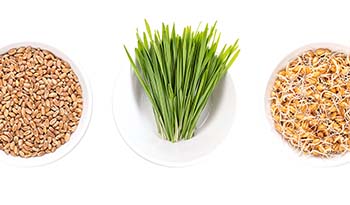5 perces útmutató: A kvercetin egészségügyi és immunrendszeri előnyei

Mi a Quercetin?
A kvercetin nemrégiben nagy figyelmet kapott az immunrendszer egészségére gyakorolt hatásairól szóló tudományos tanulmányok miatt. Kifejezetten a légzőrendszerrel szembeni fokozott immunitás előmozdítására irányuló hatása és a cinkegyes vírusellenes hatásainak erősítésében betöltött szerepe miatt.
A kvercetin egy flavonoid, növényi pigmentek csoportja, amely nagyrészt felelős sok gyümölcs és virág színéért. A flavonoidok számos élelmiszer, gyógynövényés fűszerekegészségügyi előnyeiért is felelősek. Például a bogyók, az étcsokoládé és a növényi kivonatok többségének (pl. ginkgo, szőlőmag, fenyőkéreg, tejbogáncsstb.) jótékony hatásairól ismert, hogy közvetlenül kapcsolódnak flavonoidtartalmukkal.
4 A Quercetin egészségügyi előnyei
A flavonoidok hihetetlen képességgel rendelkeznek arra, hogy fokozzák a szervezet reakcióját a környezeti és más biológiai kihívásokra. A kvercetin következetesen a legaktívabb flavonoidok közül a kísérleti vizsgálatokban, így ez a legjobb választás, ha a szervezet fokozott kihívásokkal küzd.
1. A kvercetin segíthet megvédeni sejtjeinket
A kvercetin szó szerint „bekapcsolóként” működhet, elősegítve bizonyos jótékony hatásokat a sejteken belül, például elősegíti a sejtek helyreállítását, miközben egyidejűleg „kikapcsolóként” működik, segítve a sejtek megvédését a károsodástól vagy fertőzéstől.
2. A kvercetin erős antioxidáns tulajdonságokkal rendelkezhet
A kvercetin jelentős antioxidáns hatásokkal rendelkezik, és fokozza a szervezet antioxidáns enzimrendszerét, hogy támogassa a testet biológiai stressz idején (immunaktiváció, gyulladás és allergia).
3. A kvercetin segíthet csökkenteni a gyulladást
A kvercetin gátolja mind a gyulladásos mediátoroknak nevezett vegyületek előállítását, mind felszabadulását, amelyek súlyosbítják a szervezet kísérletét a gyulladás kiegyensúlyozására.
4. A kvercetin segíthet az immunitás fokozásában
A kvercetin különleges hatással van az immunrendszer egészségére, és elősegítheti a légzőrendszer fokozott immunitását. Valójában a közelmúltban nagy figyelmet fordítottak a kvercetinre az immunműködésre gyakorolt hatása, valamint az ionos cinkintracelluláris szintjének növelésére való képessége miatt. Szabad ionos állapotában a cink gátolja a replikáz néven ismert enzimet, amelyet a vírusok az emberi sejtekben történő replikációhoz használnak. A kvercetin megkönnyíti az ionos cink átvitelét a sejtekbe az ionoforoknak nevezett csatornákon keresztül.
Klinikai vizsgálatok a kvercetin, az atlétikai teljesítmény és az immunitás
A kvercetin egyik tudományosan vizsgált alkalmazása az optimális atlétikai teljesítmény támogatása.
Több mint egy tucat klinikai vizsgálatban kimutatták, hogy a kvercetinnek enyhe hatása van az atlétikai teljesítmény javítására. Például egy tizenegy elit férfi kerékpáros vizsgálatában 6 hetes kvercetin-kiegészítés (napi 1000 mg) 3,1% -kal javította a 30 kilométeres időpróba teljesítményét.1 Az elit sportolóknál ez a kis javulás meglehetősen jelentős lehet.
Egy másik kerékpárosokon végzett tanulmány némileg meglepetéses felfedezést eredményezett. A vizsgálatban 40 képzett férfi kerékpáros kapott kvercetint (napi 1000 mg) vagy placebót egy 3 napos időszak előtt, alatt és 2 héttel azt követően, amelyben az alanyok napi 3 órán át bicikliztek, körülbelül 57% -os maximális munkaterhelés mellett. A kvercetin nemcsak javította a fizikai teljesítményt, hanem az eredmények valami mást is mutattak.
A 3 napos intenzív testmozgás utáni 14 napos időszakban a kvercetint kapott 20 kerékpáros közül csak 1-nél alakultak ki felső légúti torlódások és egyéb tünetek, míg ehhez képest a placebo csoportban 20 közül 9-nél légutak tünetei jelentkeztek.2
Az eredmények valójában nem voltak annyira meglepőek. A kvercetin számos jótékony hatással van a fehérvérsejtek működésére, és némi védelmet nyújt a légúti vírusok ellen. Segíthet a fehérvérsejtek áthelyezésében a szükségszerű területekre, és növelheti képességüket az idegen molekulák elpusztítására. A sejttenyészetekben található kvercetin kimutatta, hogy számos különböző típusú vírussal csökkenti az emberi sejtek fertőzőképességét, valamint csökkenti a vírusreplikáció sebességét különböző útvonalakon keresztül.3
Ez a meglepő felfedezés 1 002 18 és 85 év közötti felnőtt részvételével végzett utólagos vizsgálathoz vezetett.4 A cél a kvercetin (500 és 1000 mg/nap) két különböző dózisának (500 és 1000 mg/nap) hatásának mérése volt a placebóval összehasonlítva a megfázás vagy felső légúti fertőzés (URTI) tüneteire.
Az alanyok 12 hétig fogyasztották a kiegészítőket, és naponta észlelték az URTI tüneteit. Nem észleltek szignifikáns általános hatást, de amikor a csoportkülönbségeket vizsgálták, amelyeket a 40 éves és idősebb alanyok fizikailag alkalmasnak értékelték magukat, a napi 1000 mg kvercetin szedése 36% -kal csökkent a légúti tünetek és 31% -kal csökkent a betegnapok száma a megfelelő placebo csoporthoz képest.
Ezek az eredmények azt mutatják, hogy napi 1000 mg dózisban a kvercetin bizonyos előnyökkel járhat az immunfunkció javításában. Lehetséges, hogy nagyobb dózisra vagy biológiailag hozzáférhetőbb kvercetin-készítmények alkalmazására lehet szükség ahhoz, hogy más csoportokban előnyöket mutassanak.
Kvercetin, cink és szinergia C-vitaminnal
Bár a kvercetinnek van néhány közvetlen hatása, amely véd a vírusfertőzés ellen, fő hatása talán az úgynevezett ionoforként működik, és elősegíti a szabad, kötetlen cink sejtekbe történő szállítását.
Szabad, ionos állapotában a cink számos vírus replikációját gátolhatja. Amikor sok vírus megfertőz egy sejtet, beilleszti genetikai kódjának egy darabját és egy replikáz nevű enzimet, hogy lehetővé tegye a vírus replikációját. A cink képes blokkolni a replikáz enzimet, és ezért blokkolja a vírus replikációját vagy terjedését. Ez az egyik oka annak, hogy a cink népszerű ajánlás a megfázás ellen.
Annak érdekében, hogy a cink ilyen hatással legyen a vírusreplikázra, azonban egy nyitott „ionofortól” függ - egy speciális sejtmembráncsatornától, amely lehetővé teszi az ion bejutását a sejtbe. A kvercetin cink-ionoforként működhet, hogy növelje az ionos cink szintjét a sejtekben, hogy megvédje a vírus replikációját. A kvercetin e hatása magyarázhatja a fent leírt vizsgálatokban észlelt légúti fertőzések számának csökkenését.5
A kvercetin másik partner tápanyaga a C-vitamin. Ha a C-vitamint és a kvercetint kémcsöves vizsgálatokban kombinálják, immunerősítő és vírusellenes hatásuk szinergikusan jobb eredményt eredményez, mint ha bármelyiket önmagában adjuk.6
A C-vitamin képes regenerálni az aktív kvercetint a szervezetben. Amikor egy antioxidáns a szabad gyökök semlegesítésében látja el funkcióját, az inaktív formává változik. A kvercetin esetében a C-vitamin képes újrahasznosítani azt aktív formájába. Ezért nagyon fontos, hogy a C-vitamin szintje az étrendben és a kiegészítésen keresztül megfelelő legyen.
A magas C-vitamin-tartalmú ételek rendszeres fogyasztása mellett (gyümölcsök, gyümölcsök, citrusfélék és mangó; zöld leveles zöldségek; brokkoli; paprika stb.) további C-vitamin-kiegészítés is ajánlott (legalább napi 60 mg, de az optimális támogatás érdekében legalább 250 mg).
A kvercetin felszívódásának kérdése
Humán abszorpciós vizsgálatokban kimutatták, hogy a kvercetin rosszul felszívódik, és nagyfokú variabilitással rendelkezik egyik személyről a másikra.
A kvercetin gyenge felszívódásának problémájának kezelésére az egyik innovatív megoldás a kvercetin komplexesítése egy LipoMicel MatrixTM-on belül. Ez az új technológia egyedülálló folyamatot használ, amely akár tízszeresére növeli a kvercetin felszívódását a szokásos kvercetin porhoz képest.
Mi az a liposzóma?
A liposzómák két réteg zsírmolekulából álló sejtek, amelyek védik a vízből és vízben oldódó hatóanyagokból álló belső rekeszt. A vízben oldódó összetevőt, például a C-vitamin -t a belső rekeszben védi a liposzómális szerkezet.
A kvercetin liposzómái nem lehetségesek, mert a kvercetin nem vízben oldódik, de kiderül, hogy a kvercetint tökéletes jelöltté teszi a LipoMicel MatrixTM létrehozására szolgáló technológia használatára.
Mi az a Micelle?
A micellák abban különböznek a liposzómáktól, hogy „belülről kifelé” vannak a liposzómákhoz képest. Pontosabban, a micellát létrehozó zsíros anyagok külső rétegén vízszerető (hidrofil) „fej”, belül pedig zsírszerető (zsírszerető) „farka” van.
A LipoMicel MatrixTM kvercetin megoldja azt a kérdést, hogy a kvercetin nem oldódik vízben. Mivel a kvercetin zsírkedvelő, a LipoMicel MatrixTM létrehozásának folyamata során a micella közepén lévő zsírmolekulák farka tartja a helyén. A képződött micellák olyan kicsik, hogy a LipoMicel MatrixTM kvercetin vízben keverhetővé válik. Valójában, ha a Natural Factors Quercetin LipoMicel MatrixTM tartalmát tartalmazó lágy gél tartalmát egy pohár vízbe nyomja, az könnyen keveredik. A micellákat gyakran használják „nanoemulziók” létrehozására, amelyek általában keverhetetlen formák, például olaj és víz, vagy ebben az esetben kvercetin és víz keverékei.
Kvercetin: Adagolási szempontok
Amint fentebb leírtuk, a szokásos kvercetin rosszul szívódik fel, mert vízben nem oldódik. Mindazonáltal a klinikai vizsgálatokban napi 1000 mg-os dózisban észleltek bizonyos előnyöket.
Ennek ellenére a tudományos irodalom áttekintése során a kvercetin jobban felszívódó formája, amely következetesebb és magasabb vérszintet termel, kiváló eredményeket hozhat.
A természetes tényezők Quercetin LipoMicel MatrixTM adagja napi 250-500 mg. Minden lágy gél kapszula 250 mg kvercetint tartalmaz a LipoMicel MatrixTM alkalmazásban. Az előzetes abszorpciós adatok 5-10-szer nagyobb abszorpciót mutatnak ebben a fejlett formában a szokásos kvercetinhez képest. Ez azt jelzi, hogy a Quercetin LipoMicel MatrixTM minden kapszulája 1250-2500 bioekvivalenciával rendelkezik a szokásos kvercetin porral. Ha naponta két kapszulát veszünk be, a bioekvivalencia 2500 - 5000 mg normál kvercetinre nő.
Kercetin: Biztonság és gyógyszerkölcsönhatások
A kvercetin minden formája jól tolerálható emberben, a klinikai vizsgálatokban nem észleltek mellékhatásokat, vagy még az adag növelésével sem várhatók.
Fontos rámutatni, hogy a kvercetin fokozhatja bizonyos gyógyszerek, köztük a vinblasztin, a ciklosporin, a digoxin, a fexofenadin, a lozartán, a nifedipin, a felodipin, a verapamil és a terfenadin felvételét a bélből. Ezeknek a gyógyszereknek a dózisát csökkenteni kell a toxicitás elkerülése érdekében.
Mindig fontos, hogy először konzultáljon orvosával a megfelelő ellenőrzés érdekében, mielőtt módosítaná étrendjét vagy rutinját.
Referenciák:
- MacRae HS, Mefferd KM. Az étrend antioxidáns kiegészítése kvercetinnel kombinálva javítja a kerékpáros időpróba teljesítményét. Int J Sport Nutr Exerc Metab. 2006; 16 (4): 405-419.
- Li Y, Yao J, Han C és mtsai. Kvercetin, gyulladás és immunitás. Tápanyagok. 2016; 8 (3) :167.
- Nieman DC, Henson DA, Gross SJ és mtsai. A kvercetin csökkenti a betegségeket, de nem az immunrendszeri zavarokat intenzív testmozgás után. Tudományos Sport Exerc közreműködésével 2007; 39; 1561—1569.
- Heinz SA, Henson DA, Austin MD és mtsai. Kvercetin-kiegészítés és felső légúti fertőzés: randomizált közösségi klinikai vizsgálat. Pharmacol Res 2010; 62:237-242.
- Dabbagh-Bazarbachi H, Clergeaud G, Quesada IM és mtsai. A kvercetin és az epigallokatechin-gallát cink-ionofor aktivitása: a Hepa 1-6 sejtektől egy liposzóma modellig. J Agric Food Chem. 2014 augusztus 13; 62 (32): 8085-93.
- Colunga Biancatelli RML, Berrill M, Catravas JD, Marik PE. Kvercetin és C-vitamin: Kísérleti, szinergikus terápia a SARS-CoV-2 kapcsolódó betegségek (COVID-19) megelőzésére és kezelésére. Front Immunol. 2020; 11:1451.
- Riva A, Vitale JA, Belcaro G és mtsai. Quercetin fitoszóma® triatlon sportolókban: kísérleti nyilvántartási tanulmány. Minerva Med. 2018 augusztus; 109 (4): 285-289.
- Kawai Y. A flavonoidok metabolikus átalakulásának és molekuláris hatásainak megértése vivo:új stratégiák felé a természetes polifenolok hatékony felhasználására az emberi egészségben. J Med Invest. 2018; 65 (3.4): 162-165.
FELELŐSSÉGKIZÁRÓ NYILATKOZAT:A jelen blognak nem célja diagnózis felállítása...














































































 Tartalomjegyzék
Tartalomjegyzék



